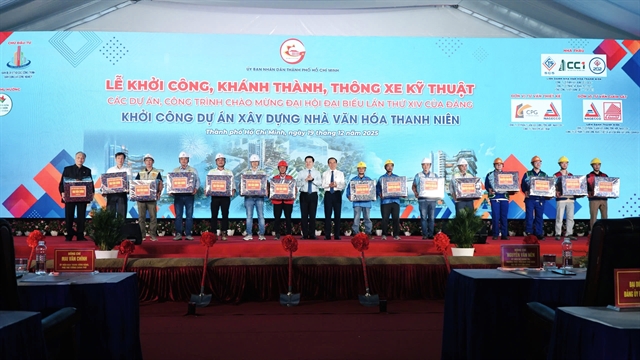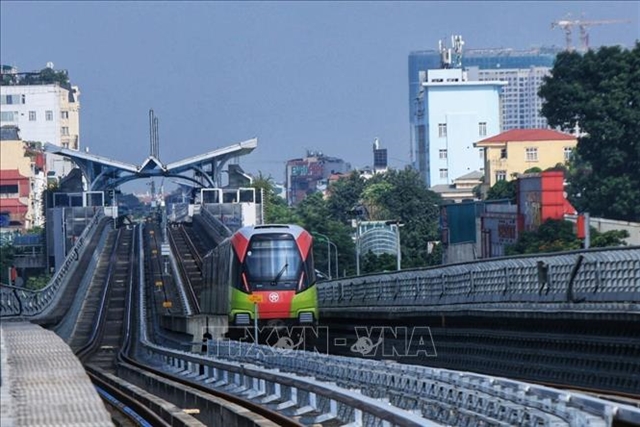 Sunday/Weekend
Sunday/Weekend
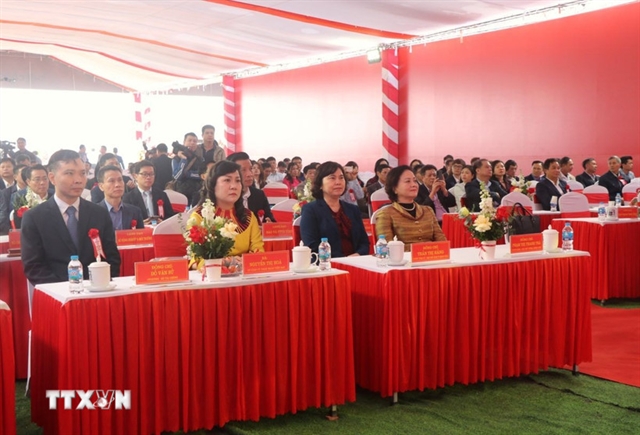
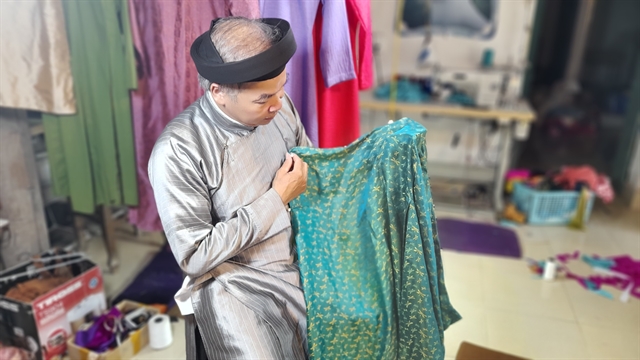 |
| Đỗ Minh Tám, one of the celebrated dressmakers of Trạch Xá Village. — VNS Photo Thanh Nga |
By Thanh Nga
(Additional reporting by Kiều Trinh and Lyly Cao)
We had the opportunity to visit Trạch Xá Village on a delightful autumn day, where the sun shone golden rays onto the landscape. The path leading into the village was adorned with lotus ponds and rows of lush trees.
Situated in Hòa Lâm Commune, Ứng Hòa District, about 60km from central Hà Nội, Trạch Xá is known for its tailor-made áo dài - Vietnamese traditional long dress.
For centuries, the village's skilled dressmakers have played a vital role in preserving the iconic Vietnamese costume.
According to village elders, the art of making áo dài in Trạch Xá dates back to over a thousand years. It is said that Nguyễn Thị Sen, the fourth wife of King Đinh Tiên Hoàng, acquired dressmaking skills from palace seamstresses. Upon her return to her native village Trạch Xá, she taught the craft to the villagers. Over time, it was passed down and is now the primary occupation of the majority of Trạch Xá's residents.
Despite modern áo dài creations being prevalent, Trạch Xá boasts several family businesses still preserving the centuries-old designs of the national costume, such as the áo dài ngũ thân - the traditional five-panel long dress. One such artisan is Đỗ Minh Tám, who has revived the art of crafting the five-panel long dress.
In a modest workshop adorned with vibrant silk fabrics, Tám meticulously sews each layer of fabric with great care. His current project involves making five-panel long dresses for a number of female teachers in the area.
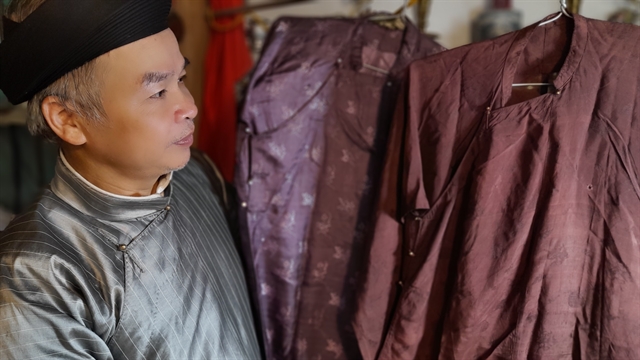 |
| Artisan Đỗ Minh Tám and some five-panel long dresses made in 1955. — VNS Photo Thanh Nga |
Tám explains that the five-panel dress differs from the modern áo dài creations.
"A five-panel dress consists of two pieces of cloth for the front, two for the back, and an inner piece for right chest. In the past, when fabric widths were narrow at around 40cm, two cloth pieces had to be sewn together to make a dress body," Tám told Việt Nam News.
The five-panel áo dài originated in the mid-18th century in the Huế court of Lord Nguyễn Phúc Khoát. It transcended social boundaries and was worn by people from all walks of life. As time passed, a more convenient version of the outfit gained popularity and eventually replaced it.
For those who cherish the five-panel áo dài, this ensemble fulfils all the requirements of a costume, bestowing a distinctive poise and figure upon men and an elegant allure on women.
The long dress also carries profound symbolism: the four panels in the front and back represent the father, mother, father-in-law, and mother-in-law, while the inner one represents the wearer. The intricate sewing techniques of the dress are prominently displayed in the meticulous stitching of patterns at the hem, ensuring perfect alignment and straight, small, even, and concealed thread lines.
Tám says that despite his deep passion for the traditional long dress, the rise of the market economy led to the dominance of the modern áo dài trend.
During the long time of wars and economic depression, the traditional five-panel long dress gradually faded away. It became rare and unpopular, resulting in a significant decline in customers. Most dressmakers in Trạch Xá were compelled to modify their designs.
 |
| More and more people love traditional costumes. — Photo courtesy of Tám |
"As innovative áo dài could be mass-produced in various styles and colours, each year it underwent changes catering to individual tastes, making it challenging to preserve its original cultural value. Traditional áo dài, on the other hand, remained faithful to a single style. Its cultural significance endured," Tám says.
Despite challenges, Tám has adapted to the pace of modern life while striving to preserve traditional design. His return to crafting the five-panel long dress was inspired by his desire to maintain national heritage, as well as the support of the Đình Làng Việt (Vietnamese Village Communal House) Club.
"In 2017, members of the Đình Làng Việt Club, who share a deep love for Vietnamese traditions, approached me with a request to revive the five-panel long dress to preserve this national costume. So when I decided to resume making the dress with traditional designs, I faced numerous challenges," Tám says.
Thanks to the ingenuity and creativity of artisans like Tám, the five-panel long dress has woven itself back into the fabric of everyday life.
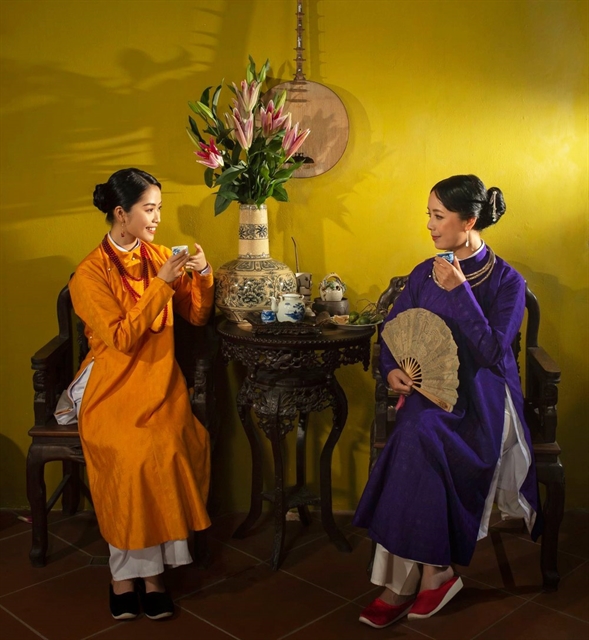 |
| In recent years, the traditional five-panel long dress has garnered attention from young people eager to preserve the nation's traditional culture. — Photo lamia.com.vn |
In recent years, the five-panel long dress has drawn attention from young people eager to preserve traditional culture. The growing popularity of the dress is evident through the emergence of associations, groups, and fan pages such as the Đình Làng Việt, Đại Việt Cổ Phong (Đại Việt Traditional Customs), and Việt Nam Cổ Phục Hội (The Vietnamese Traditional Costumes Association).
Through the dedication of artisans like Tám, the timeless beauty of the five-flap long dress continues to thrive, bridging the gap between tradition and modernity. This resurgence has renewed the allure of the fashion.
 |
| Artisan Đỗ Minh Tám’s dress sewing kit. — VNS Photo Thanh Nga |
Secrets of craft village
Trạch Xá craft village continues to develop thanks to the delicate skill of horizontal hand-stitching. This technique, known only to the local artisans, is an integral part of creating the traditional dress.
Despite the availability of sewing machines, many dressmakers in Trạch Xá still prefer hand sewing, particularly when working on a traditional áo dài.
“It often took us about two years to master this method. The way we hold the needle often leads to pricked fingers. After two years of learning hand-stitching, we moved on to machine stitching,” Tám said.
Observing Tám at work, it is difficult to see his needle as it moves swiftly through the fabric. Once the outfit is completed, the inside edge appears seamless, with no visible stitches, while the outside of the fabric exhibits straight and even stitches.
In addition to the horizontal stitching technique, Trạch Xá dressmakers traditionally use the yarn taken from the same piece of cloth to sew the dress.
“In the past, we did not have sewing machines, and hand-sewing a dress took one or two weeks. Our ancestors used the yarn pulled from the same piece of cloth as thread to sew, ensuring that the stitches were concealed in the dress. We still do it that way today,” Tám said.
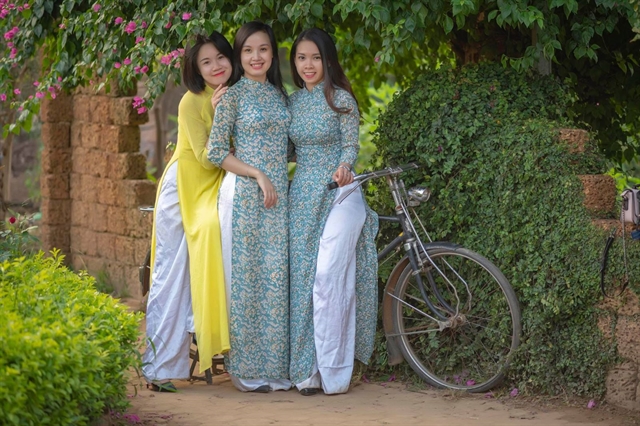 |
| Traditional long dress brings graceful beauty to Vietnamese women. — Photo baothainguyen.vn |
Both traditional and modern
According to Nguyễn Thị Dung, deputy village chief, Trạch Xá comprises over 500 households, with about 90 per cent engaged in making áo dài.
The tailoring art is passed down from generation to generation, with children as young as 8 to 10 years old being introduced to the trade and becoming proficient in sewing by the time they reach 15 to 16. Many families have multiple generations working together.
Artisan Nghiêm Văn Đạt has dedicated decades to making áo dài, and is one of the most successful dressmakers in Hà Nội. His shop Áo Dài Tiến Đạt – Trạch Xá in Chùa Bộc Street is well-known for making long dresses, both traditional and modern, for men and women.
Đạt, 60, remains actively involved in the industry as chairman of the Trạch Xá Craft Village Association.
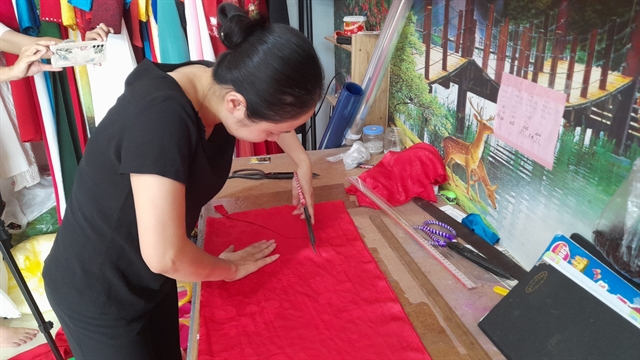 |
| Young dressmaker Vũ Thị Hằng in Trạch Xá Village has studied dressmaking that aligns with market demands. — VNS Photo Thanh Nga |
Young dressmaker Vũ Thị Hằng emphasises the importance of blending traditional craftsmanship with contemporary fashion. She has studied dressmaking that aligns with market demands. Traditional áo dài emphasises softness and grace, while modern creations incorporate current fashion elements.
Despite the changing social landscape, the younger generation in Trạch Xá maintains a commitment to the craft. The village artisans have spread their expertise throughout the country, opening shops in major cities. They draw in customers due to the uniqueness of the hand-sewn áo dài, which features even and straight stitches and a graceful shape, while showcasing the beauty of Vietnamese women.
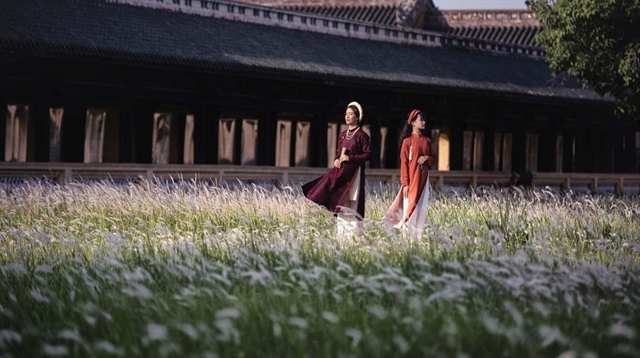 |
| The 'áo dài' has long been Việt Nam’s traditional outfit and a typical cultural characteristic of the country. — Photo vov.vn |
Trạch Xá's long dresses have been showcased in numerous craft fairs across the country. The village has also become a cultural landmark for tourists at home and from abroad.
Trạch Xá was recognised as a traditional dressmaking village by the culture ministry in 2004, and is currently seeking recognition of the craft as an intangible cultural heritage of the nation. VNS

